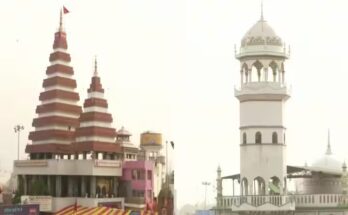
By Pushpan
Russia had deployed 150,000 troops on the Ukrainian border and established permanent shelters, supply and logistic chains, due to which NATO commanders feared full invasion of Ukraine. This massive force is perhaps the largest build-up in Europe since the cold war.
Talks between Russian and Western diplomats to reduce tension have failed, with no signs of normalization. NATO has expanded right to the doorsteps of Russia and President Putin obviously felt threatened for the national security of his country. After all, the Baltic States and six out of eight members of the Warsaw pact, are now in NATO.
What was the background of tensions between the two countries that ultimately led to full scale invasion of Ukraine?
Mr. Putin has often commented that Western values of democracy are unworkable with the orthodox Slavic Russia. Mr. Putin loves being at the helm of affairs and has passed laws that ensure his presidency up to around 2040. Since Ukraine has the same demographics as Russia and if Ukraine was to become a thriving democracy, it will stand as a rebuke to Mr. Putin’s claim and become an attractive model for the Russian population.
Mr. Putin definitely wishes to avoid any internal unrest and use the external NATO threat to justify his repressive regime. Russia had issued a list of demands to NATO, which if met, will lead to Russian withdrawal.
These demands were; NATO to cease further expansion, US to no longer protect its allies with tactical nuclear missiles, short- and medium- range missiles, in effect a veto over troop deployments and military exercises in eastern Europe and military cooperation with former Soviet countries. Russia also wants NATO to withdraw all the limited troops stationed in eastern Europe deployed by NATO after the Russian annexation of Crimea in 2014.
It was as if Russia wanted the talks to fail, which would have provided President Putin a pretext to invade Ukraine. Even the Russian media was stunned by the audacity of the demands. The game played by Mr. Putin was particularly brilliant. Even if NATO conceded to these demands, Mr. Putin would have secured a major diplomatic victory and when NATO played hard ball, Mr. Putin could secure a perfect military mileage.
President Putin was sure NATO would risk a military confrontation with nuclear power Russia. The US in 2008 had persuaded other NATO members to accept Georgia and Ukraine as NATO members. But when later Russia seized one-fifth of Georgia, NATO didn’t accept Georgian membership.
NATO presently is in no condition to admit Ukraine and it is likely to let down Ukraine gently, without giving the impression that Russia has a veto over the alliance’s expansion.
From Mr. Putin’s perspective, his decision to invade Ukraine now makes sense. If Ukraine joins NATO in the future, it would be nearly impossible to invade Ukraine, as Ukraine can invoke Article 5 of NATO in face of a Russian invasion. Same goes with Sweden and Finland.
Historically, both countries have been neutral during the cold war. But recently, Sweden and Finland have increased political and military cooperation with NATO significantly. The Swedish parliament has even accepted to make a formal request to NATO for its membership. Meanwhile, Finland has decided to keep its options open for now.
In response, Russia has warned of serious political and military consequences.
The irony is that Russia’s efforts to prevent NATO’s eastward expansion may actually end up achieving precisely the opposite. The Russian aggression could result in more and more countries, especially former Soviet republics, exploring the possibility of NATO membership. For instance, the Russian invasion of Crimea in 2014 strengthened the alliance, pushed defence spending in Europe and led to the very NATO deployments that Mr. Putin now wants to be withdrawn.
President Putin believes that the US is preoccupied with China at the moment and he seeks to take advantage of the situation and expand Russia’s sphere of influence.
The Russian deployments in Armenia after the truce with Azerbaijan under the umbrella of Collective Security Treaty Organization (CSTO) is a stark example of how Mr. Putin seeks to restore Russian influence over the former Soviet states. Being a former officer in the KGB, Mr. Putin has publicly stated the dissolution of the Soviet Union to be the greatest blunder of the 20th century and his attempts hint at the possibility of efforts to re-establish the Soviet Union under the umbrella of Mother Russia, as often proclaimed by Russian nationalists. Also, it appears that Mr. Putin often feels betrayed by NATO.
Mr. Putin is against the post-cold war order, and Russia’s exclusion from it. In his narrative, the US and NATO took advantage of Russia’s weakness in the 1990s and early 2000s by not keeping their promises not to expand NATO, by waging war on Serbia in 1999, a Russian ally and by supporting revolutions against authoritarian pro-Russian regimes in former Soviet states.
It is indeed true that NATO assured Russia it would not expand, and even cut down its armed forces and defence spending significantly after the end of the cold war. However, it is also true that Russia willingly accepted NATO’s expansion when NATO changed its stance.
In 1997, when Poland, Czech Republic and Hungary joined NATO, NATO and Russia signed a “Founding Act” in which Russia accepted NATO’s enlargement. In exchange, NATO ruled out deployment of substantial combat troops and nuclear weapons in eastern Europe, a constraint it observes to this day. The US also withdrew a huge number of troops and European nations shrank their armed forces dramatically.
One thing to particularly note is the great deal of mistrust between the two sides, with each claiming the actions of the other hostile. Whose action is actually hostile is very debatable and thus bears no straightforward answer.
For instance, in 2019, the US abandoned the Intermediate Range Nuclear Forces (INF) treaty which debarred both sides from having land-based missiles having ranges between 500 km and 5500 km, arguing that the Russian missiles violated it. For its part, Russia claims that the missile interceptors like Terminal High Altitude Area Defense (THAAD) and Aegis Ashore Ballistic Missile Defense System (AABMDS) under construction in Romania and Poland can be repurposed as offensive missile launchers. Also, Mr. Putin feels that NATO missiles in Ukraine could reach Moscow and St. Petersburg in minutes. For its part, Russian missiles in Kaliningrad could reach Berlin in minutes. The distances are less than 600 km. NATO complains that Russia violated rules requiring countries to give advance notice of large exercises like Zapad – by pretending that large drills are in fact a combination of smaller, separate ones. Russia, for its part, maintains NATO has failed to consider its suggestions.
The conflict may escalate and lead to World War III. Reciprocal confidence building measures demand sacrifice and restraint, and whether any of the sides would be willing to do so, remains to be seen.
( Author is B Tech student from BITS, Pilani)



